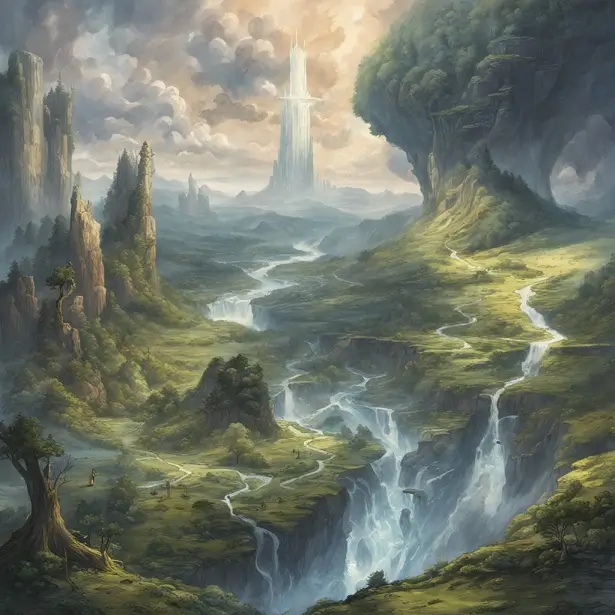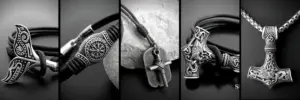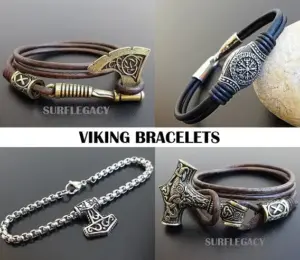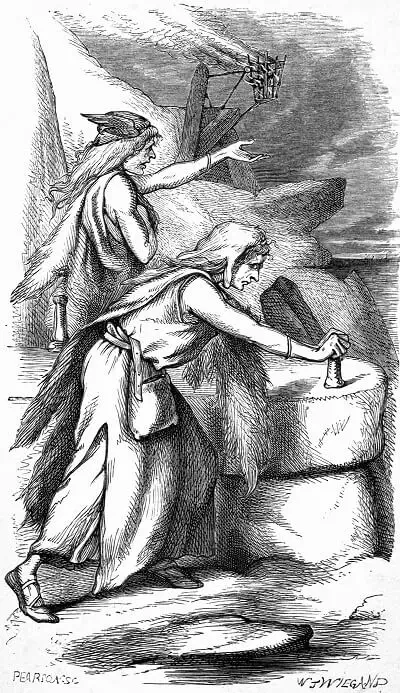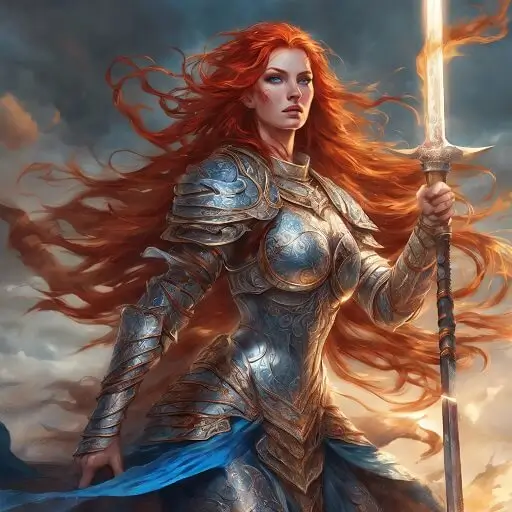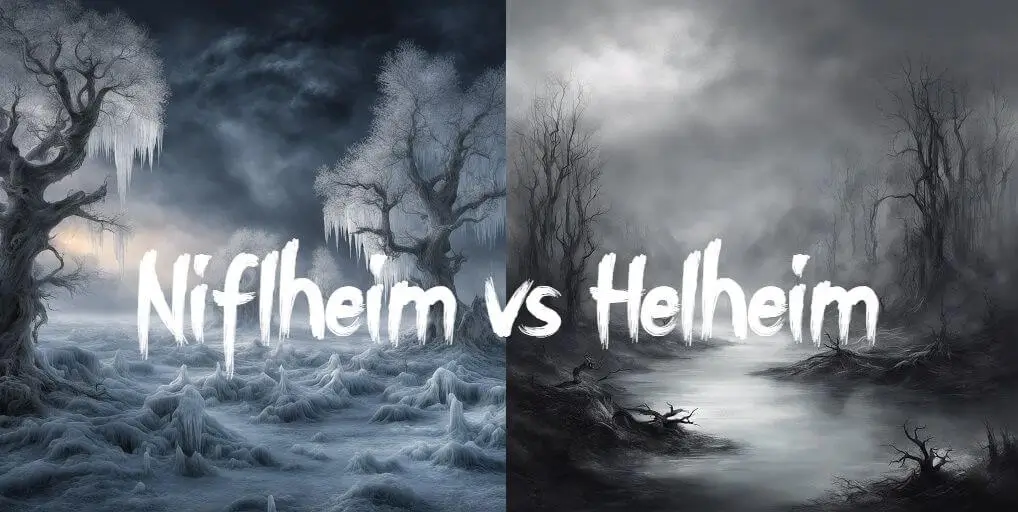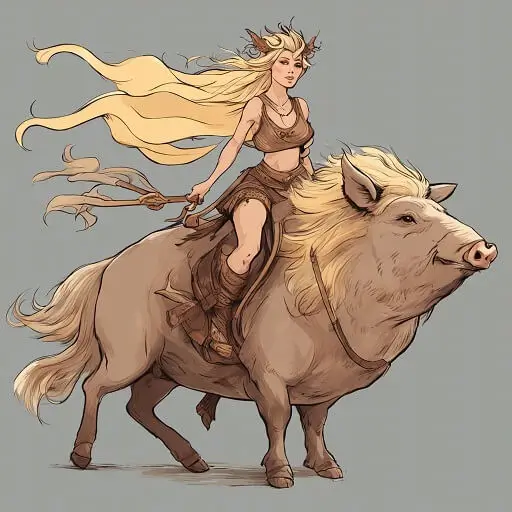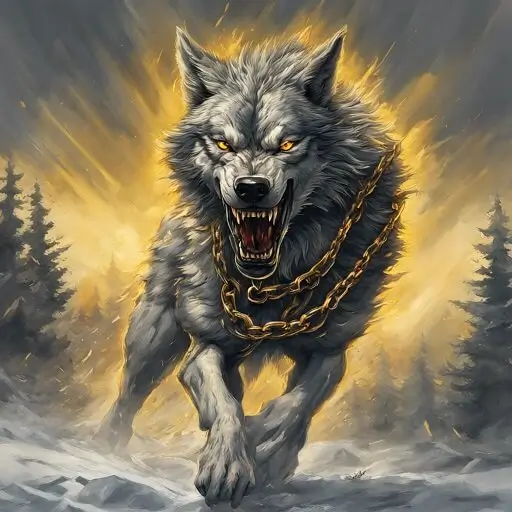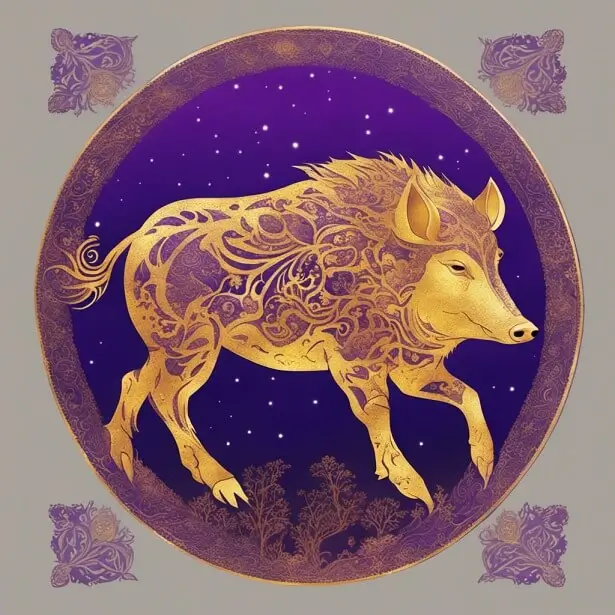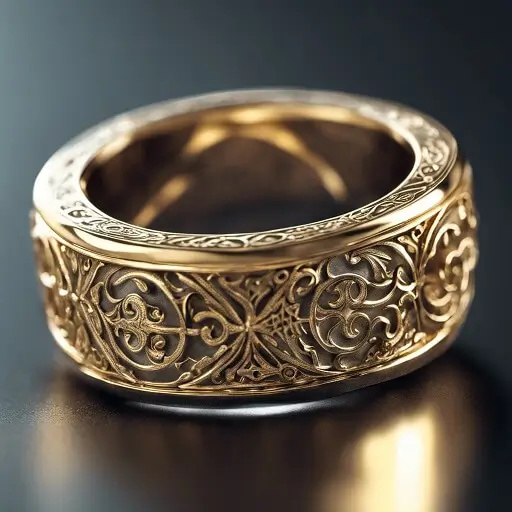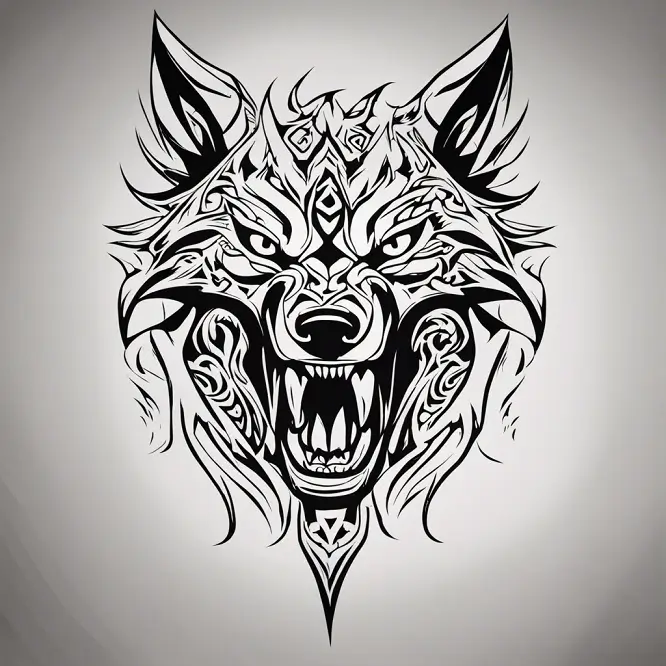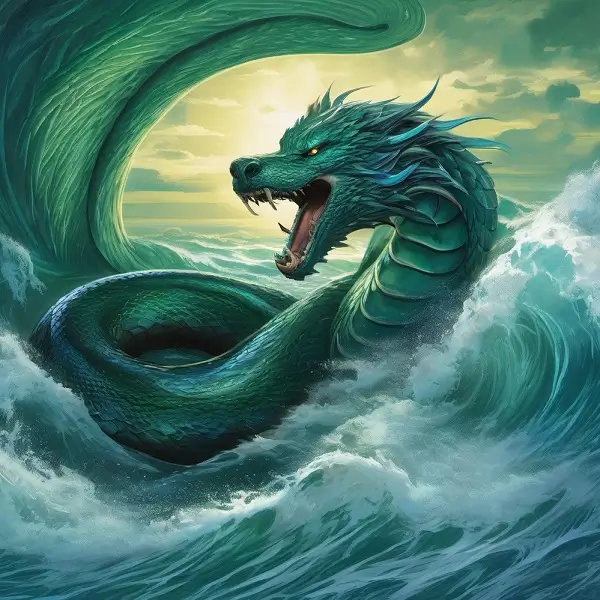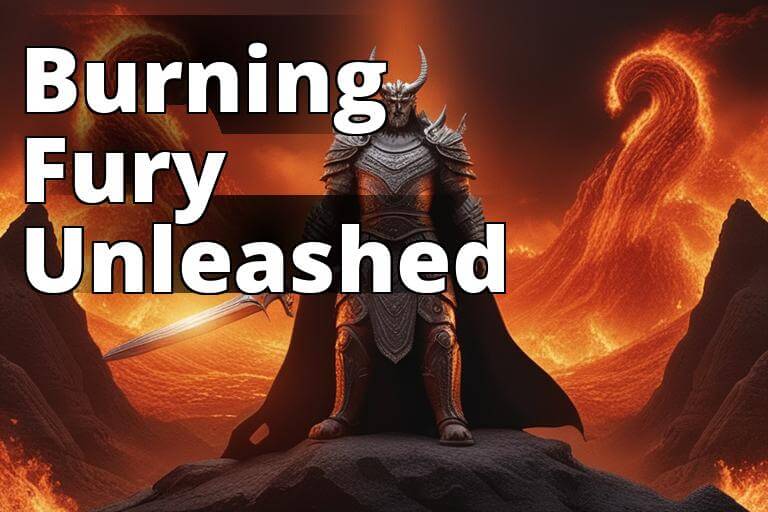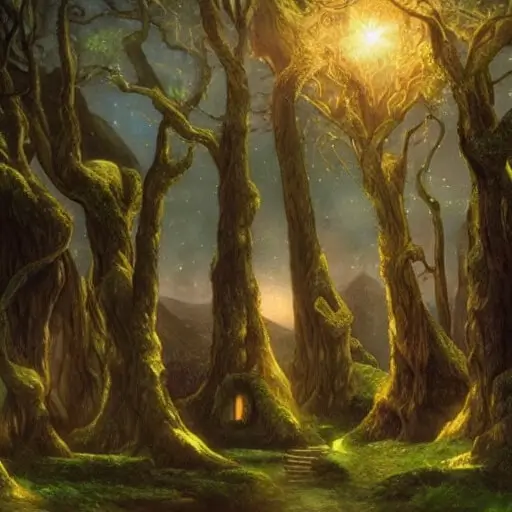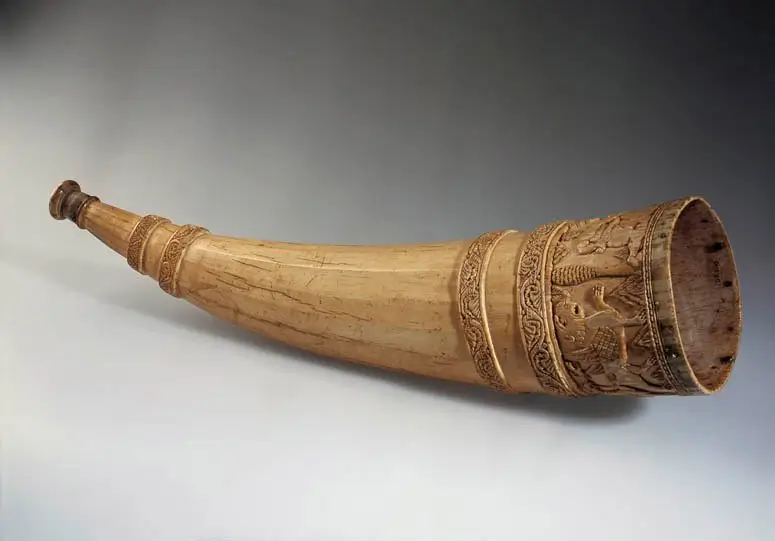Midgard is one of the Nine Worlds in Norse cosmology and mythology. It represents the realm of humankind and civilization, located in the center of the cosmos.
The Old Norse term “Midgard” literally translates to “middle yard” or “middle enclosure,” referring to its central position in the Norse mythical universe. Midgard plays a pivotal role in Norse legends and beliefs about the creation and destruction of the world.
What you will learn from this article:
- The meaning and etymology behind the name Midgard
- How Midgard was created from the body of the giant Ymir
- Midgard’s central location among the Nine Worlds of Norse cosmology
- Myths about gods like Thor defending Midgard from chaos forces
- The role of Ragnarok and flooding in Midgard’s fate
- Midgard’s influence on fantasy worldbuilding traditions
Etymology
The Old Norse term “Midgard” derives from the words “mið” meaning middle and “garðr” meaning yard or enclosure. Cognate terms appear in related ancient Germanic languages including Old English “middangeard,” Old Saxon “middilgard,” Old High German “mittilagart,” and Gothic “midjun-gards.”
The English term “Middle-Earth,” popularized by J.R.R. Tolkien, draws directly from the Old English “middangeard.” Tolkien was inspired by Old English poetic references to middangeard and mythological parallels.
Meaning and Significance of Midgard
The double meaning of Midgard refers to its central location in the cosmos, surrounded by other worlds. Along the horizontal plane, Midgard lies encircled by the wilderness and realms of chaotic, often antagonistic giants, creatures, and the vast outer ocean.
Along the vertical dimension of the world-tree Yggdrasil, Midgard rests in the middle with the divine realm of Asgard above and the underworld realm of Hel below.
This embodies the core innangard vs utangard concept in Norse religion. Innangard represents the civilized order within the protected cosmic enclosure. Utangard is the anarchic wilderness existing beyond the border fences.
Midgard falls somewhere in between, balancing these opposing aspects. The etymological cognates garð and yard reflect Midgard’s purpose as an enclosure.
Creation of Midgard
The cosmogonic myth shared with Odin by the seeress in the Völuspá describes how the gods, specifically Odin and his brothers Vili and Ve, shaped Midgard as an enclosure for humankind.
After slaying the primordial giant Ymir, they split his corpse and formed the cosmos – his flesh became the earth, blood the seas, bones the mountains and cliffs, skull the dome of sky, and brains the clouds.
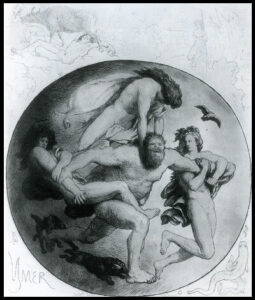
Ymir killed by the sons of Borr
As described in the Grímnismál, the happy gods specifically fashioned Midgard out of Ymir’s brow as a protected stronghold for the sons of men, using his eyebrows to build a fence guarding against outside hostility.
This aligns with Snorri’s account where the gods formed the disc-shaped earth surrounded by the deep sea. They situated hostile giants along the sea’s edge, but constructed an inland human realm using Ymir’s eyebrows as fortification against the giants’ enmity. Snorri also refers to Midgard as the shared dwelling of gods and humans.
After shaping the earth, Odin, Vili and Ve discovered two logs of driftwood – an ash and elm – on the new shoreline. Transforming them into the first humans Ask and Embla, the gods endowed them with vital attributes like spirit, reason and perception. They situated their human creations together in the protected realm of Midgard to populate this new middle world.
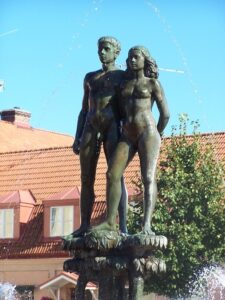
Ask and Embla sculpture in Sweden
Midgard and the Nine Worlds
In Norse cosmology, Midgard is one of nine interconnected worlds encircled by the ocean and joined by the world-tree Yggdrasil. It’s located in the middle, with Asgard and Vanaheim (realms of gods) above, Jotunheim (giants) and Niflheim (mist world) alongside, and Hel and Svartalfheim (underworlds) below.
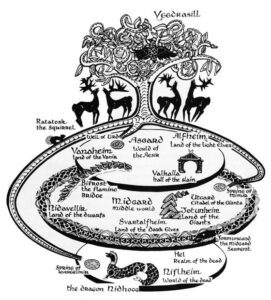
Yggdrasil and the 9 worlds
The ocean surrounding Midgard contains threats like the Midgard Serpent Jörmungandr, preventing easy passage beyond. The Bifrost rainbow bridge provides a way for gods to travel between Asgard and Midgard.
The Nine Worlds of Norse Cosmology:
| Realm | Description |
|---|---|
| Asgard | Home of the Aesir gods like Odin & Thor |
| Vanaheim | Home of the Vanir gods like Freyr & Freyja |
| Alfheim | World of the light elves |
| Svartalfheim | Underground world of the dark elves |
| Jotunheim | Wild realm of the giants |
| Niflheim | Cold, misty underworld |
| Muspelheim | Fiery realm of the fire giants |
| Hel | Underworld ruled by the goddess Hel |
| Midgard | Middle realm between extremes where humans dwell |
Thor as Defender of Midgard and His Battle with Jörmungandr
Several Norse myths and legends highlight the struggle between Thor, god of thunder and protector of the middle realm, against Jörmungandr, the monstrous serpent dwelling in the oceans encircling Midgard. Their archetypal conflict reinforces Midgard’s perilous situation between the forces of order and chaos.
One prominent myth describes Thor going fishing with the giant Hymir using an ox head for bait. Thor manages to hook and haul up the immense body of Jörmungandr, smashing the serpent on the head with his divine hammer Mjolnir. This causes the earth to shake and volcanoes to erupt.
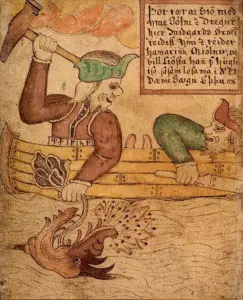
Thor going fishing with the giant Hymir
But before Thor can kill his nemesis, Hymir cuts the fishing line, allowing the giant snake to sink back beneath the waves. Their fated final battle will come at Ragnarok when Thor will slay the serpent but die from its venomous bite after walking just nine paces away.
Odin and Gods Meddling in the Affairs of Humans
The gods, especially Odin, play an active role in the legends influencing the affairs of human heroes and tribes in Midgard. Odin will often favor one side in important battles and alter the course of human events through actions of himself or his magical daughters, the Valkyries. He demands sacrifice and allegiance in exchange for his divine favor.
In the poem Rígsþula, the god Ríg (likely Odin in disguise) sires the progenitors of the three main social classes by fathering children with human women – thralls (slaves), karls (freemen), and jarls (nobility). The young jarl Jarl is especially beloved and mentored by Ríg to launch a new royal dynasty chosen by the gods. This illustrates how the gods shape history through their relationships with mortals.
The god Heimdall is described in Völuspá as the forefather of mankind whose offspring inhabit the various human classes. Thor also plays a protective role for humans against the destructive forces of their world. His daughter Thrúd was invoked by Viking warriors for her power in battle.
Midgard’s Role in Ragnarok
Ragnarok refers to the cataclysmic events foretold to end this cycle of the Norse universe, bringing widespread death among both men and gods.
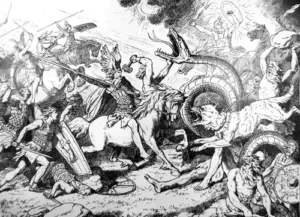
Ragnarok by Johannes Gehrts (1855-1921)
During these apocalyptic events, Midgard will be severely damaged from multiple attacks. The World Serpent Jörmungandr will rise from the ocean depths, poisoning the land and sea.
The ferocious Fenrir wolf breaks free and runs rampant while gods and giants engage in their mutual destruction. The fire giant Surt will scorch the earth in flames.
Most of Midgard will sink beneath the rising sea, killing the majority of humans and signaling the end of our known world. But a new cycle of life will eventually emerge when the earth rises again from the waves, lush and fertile.
The two sole human survivors, Lif and Lífþrasir, will repopulate Midgard and inhabit this renewed realm.
Midgard in Literature and Popular Culture
The imaginative scope of Midgard as a balance between gods and underworlds, order and chaos, has profoundly impacted later European literature and fantasy storytelling traditions. J.R.R. Tolkien adopted the Old English term middangeard in naming his Middle-Earth, which forms the setting for The Lord of the Rings trilogy and related tales.
Other significant fantasy realms modeled after Midgard include C.S. Lewis’s Narnia, J.K. Rowling’s wizarding world in the Harry Potter books and films, mythical realms in video games like God of War and The Elder Scrolls, and fictional regions of the Marvel Cinematic Universe.
These worlds echo the enchanting magic and escapism embodied by Midgard existing at an alluring crossroads between the mundane human sphere and divine dimensions.
Midgard ultimately represents a core concept in old Norse cosmology – the middle region where mortal life unfolds, not wholly wild nor wholly tamed. It forms a central stage for great myths and shaping the worldviews of medieval Scandinavian cultures while continuing to inspire fantastical fictional realms ever since.
Key Takeaways:
- Midgard literally means “middle yard/enclosure” and signifies the human realm in Norse mythology located midway between gods and underworlds
- It was created from the giant Ymir’s flesh by Odin and brothers Vili & Ve, who also made the first man and woman Ask & Embla
- Midgard rests at the base of the world tree Yggdrasil which connects it to eight other mythical realms
- Myths depict gods like Thor defending Midgard from chaotic forces like the menacing Midgard Serpent
- During Ragnarok, most of flooded Midgard will sink beneath the sea but later emerge fertile again when Lif and Lífþrasir repopulate it
- Its concept of a balanced middle realm between divine order and precarious wilderness has profoundly inspired fantasy worldbuilding
FAQ about Midgard
What does the word Midgard mean?
Midgard literally translates to “middle yard” or “middle enclosure” in Old Norse. This name signifies its place in the center of the Norse cosmos.
Where is Midgard located in Norse mythology?
Midgard lies at the base of the world tree Yggdrasil, in the middle branches separating the gods in Asgard above and underworlds like Hel below.
Who lives in Midgard in Norse legends?
Midgard is inhabited by humans as well as interactions from major gods like Odin and Thor who involve themselves in mortal affairs.
How was Midgard created according to Norse myths?
The Norse creation story describes Odin and his brothers crafting Midgard from the slain body of the giant Ymir – his flesh becoming land, blood the seas, bones mountains etc.
What happens to Midgard during Ragnarok in Norse mythology?
Much of Midgard will sink beneath the sea during the destruction of Ragnarok, though it will eventually re-emerge fertile again when Lif and Lífþrasir repopulate it to start the next cycle.
What makes Midgard special in Norse mythology?
Midgard is the only one of the Nine Norse worlds that is fully located in the mortal realm. As the homeland of humans, it represents civilization and the inhabited human world. Midgard has a central place in Norse cosmology, mythically encircled by oceans and situated in the middle of the world tree Yggdrasil. This reflects its conceptual role as a balance between opposing forces like order and chaos, the divine and the mortal. Midgard is where gods directly interact with humankind, a conduit linking different planes of existence.
Conclusion
Midgard was the central realm of humankind in Norse mythology – created by the gods, frequented by them, and pivotal in apocalyptic tales despite its mundane nature.
Beyond just a mythical place, it represents the concept of a middle ground balancing order and chaos, tamed yet untamed. Midgard gave medieval Scandinavians a lens to understand their world as encircled by forces greater than man and nature. Its creative legacy lives on through beloved fantasy realms evoking a similar wonder, magic, and escapism.
See also:
The Magical Realm of Asgard: Home to the Aesir in Norse Mythology
Niflheim: The Primordial Realm of Ice and Mist in Norse Mythology
Vanaheimr: The Realm of the Vanir Gods
Muspelheim: The Realm of Fire in Norse Mythology
Alfheim: The Luminous Realm of the Elves in Norse Mythology
Helheim: The Norse Mythological Realm of the Dead
Shop Norse Jewelry
Are passionate about Norse Mythology?
Finding the ideal piece of Norse Jewelry can be challenging and time-consuming, especially if you lack inspiration or don’t know where to look.
Surflegacy, has you covered. We have a wide range of Handmade Jewelry in various styles, shapes, colors, and materials, to accentuate your Norse spirit and look. Do not hesitate to visit our selection HERE
Whatever you wear, you’ll find the ideal trendy piece to complement your wardrobe. Our jewelry is designed to be worn every day, no matter where you go or what season is. Are you ready to step up your wardrobe game?

